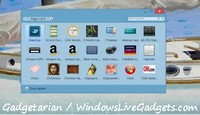Change monitor brightness easily, even with hotkeys, using ClickMonitorDDC
DDC is an abbreviation for Display Data Channel, a collection of protocols for communication between display and graphics adapter, enabling the display to communicate its supported modes to the adapter, letting the computer adjust monitor parameters, such as brightness and contrast. ClickMonitorDDC is perhaps a program you are going to enjoy a lot! It will let you control monitor settings without using the native menu of your monitor, but icons in the Windows system tray.
You can click (or mouse wheel over) the taskbar notification icons to adjust real monitor backlight brightness and contrast, increasing or decreasing corresponding values. This is more comfortable and faster than messing with monitor buttons. I use it in my Dell U2713H monitor and it works just fine!
Notification icons show monitor display values, which you can change by sliders, buttons, command lines, hot keys, context menu popup entries, batch files, or appending arguments in the shortcut target of icon properties! Commands are easy as “b 20 c 30”, which means “monitor brightness 20 and contrast 30”.
b + 1 b – 1 increases brightness by 1 and decreases contrast by 1. Assigning each of these values to a shortcut key will let you fine tune brightness rapidly! You can adjust this way the contrast, even warmness (increase or decrease the value of blue, etc.) ClickMonitorDDC works even with a second monitor. PL2779Q b 36, for instance, is a command that sets brightness to 36 for a monitor named PL2779Q.
Some monitors offer special modes with fixed brightness/contrast for games etc. In this case values adjustments will fail. If you don’t specify a monitor number, name or serial number in command-lines, the commands affect the default monitor. In the ClickMonitorDDC panel you can select a different monitor as default. ClickMonitorDDC automatically sets the monitor under the cursor as default monitor, but you can disable this feature in settings.
ClickMonitorDDC also includes a volume control, but I prefer Volume2 for this job, because it provides several interesting OSD themes.

